
Fuchsia is a genus of flowering plants that consists mostly of shrubs or small trees.

Artemisia is a large, diverse genus of plants belonging to the daisy family Asteraceae, with almost 500 species. Common names for various species in the genus include mugwort, wormwood, and sagebrush.

Artemisia vulgaris, the common mugwort, is a species of flowering plant in the daisy family Asteraceae. It is one of several species in the genus Artemisia commonly known as mugwort, although Artemisia vulgaris is the species most often called mugwort. It is also occasionally known as riverside wormwood, felon herb, chrysanthemum weed, wild wormwood, old Uncle Henry, sailor's tobacco, naughty man, old man, or St. John's plant. Mugworts have been used medicinally and as culinary herbs.

Aubrieta is a genus of about 20 species of flowering plants in the cabbage family Brassicaceae. The genus is named after Claude Aubriet, a French flower painter. It originates from southern Europe east to central Asia but is now a common garden escape throughout Europe. It is a low, spreading plant, hardy, evergreen and perennial. It has small violet, pink, or white flowers, and it inhabits rocks and banks. It prefers light, well-drained soil, is tolerant of a wide pH range, and can grow in partial shade or full sun.

Nymphaea alba, the white waterlily, European white water lily or white nenuphar, is an aquatic flowering plant in the family Nymphaeaceae. It is native to North Africa, temperate Asia, Europe and tropical Asia.

Grevillea, commonly known as spider flowers, is a genus of about 360 species of evergreen flowering plants in the family Proteaceae. Plants in the genus Grevillea are shrubs, rarely trees, with the leaves arranged alternately along the branches, the flowers zygomorphic, arranged in racemes at the ends of branchlets, and the fruit a follicle that splits down one side only, releasing one or two seeds.

Pulsatilla alpina, the alpine pasqueflower or alpine anemone, is a species of flowering plant in the family Ranunculaceae, native to the mountain ranges of central and southern Europe, from central Spain to Croatia. It is an herbaceous perennial growing to 15–30 cm (6–12 in) tall by 20 cm (8 in) wide, and can be found at altitudes of 1,200–2,700 m (3,900–8,900 ft).

Lavandula angustifolia, formerly L. officinalis, is a flowering plant in the family Lamiaceae, native to the Mediterranean. Its common names include lavender, true lavender and English lavender ; also garden lavender, common lavender and narrow-leaved lavender.
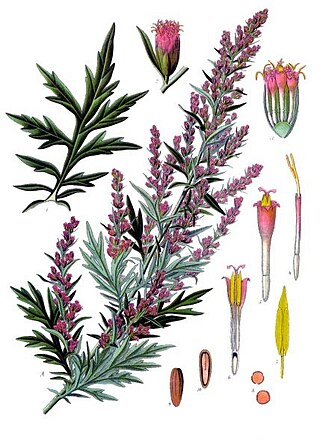
Mugwort is a common name for several species of aromatic flowering plants in the genus Artemisia. In Europe, mugwort most often refers to the species Artemisia vulgaris, or common mugwort. In East Asia the species Artemisia argyi is often called "Chinese mugwort" in the context of traditional Chinese medicine, Ngai Chou in Cantonese or àicǎo (艾草) for the whole plant in Mandarin, and àiyè (艾叶) for the leaf, which is used specifically in the practice of moxibustion. Artemisia princeps is a mugwort known in Korea as ssuk (쑥) and in Japan as yomogi (ヨモギ). While other species are sometimes referred to by more specific common names, they may be called simply "mugwort" in many contexts.
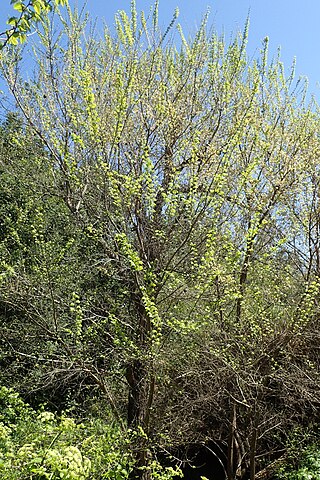
Ulmus minorsubsp.canescens is a small deciduous tree occasionally known by the common names grey elm, grey-leafed elm, and hoary elm. Its natural range extends through the lands of the central and eastern Mediterranean, from southern Italy, the islands of Sicily, Malta, Crete, Rhodes and Cyprus, and through Thrace to Turkey, and as far south as Israel, where it is now considered rare and endangered in the wild. The tree is typically found amidst the comparatively humid coastal woodlands and scrublands.

Artemisia douglasiana, known as California mugwort, Douglas's sagewort, or dream plant, is a western North American species of aromatic herb in the sunflower family.

Grevillea arenaria, commonly known as sand grevillea or hoary grevillea, is a species of flowering plant in the family Proteaceae and is endemic to New South Wales. It is a spreading shrub with elliptic to egg-shaped leaves with the narrower end towards the base, and red, pink or orange flowers.

Begonia grandis, the hardy begonia, is a species of flowering plant in the family Begoniaceae. This herbaceous perennial has alternate, simple leaves on arching stems. The flowers are pink or white, borne in dichotomously branching cymes from late summer through fall in USDA U.S. Hardiness Zone 7. As the common name "hardy begonia" implies, it is winter hardy in some temperate regions.

Artemisia campestris is a common and widespread species of plants in the sunflower family, Asteraceae. It is native to a wide region of Eurasia and North America. Common names include field wormwood, beach wormwood, northern wormwood, Breckland wormwood, boreal wormwood, Canadian wormwood, field sagewort and field mugwort.
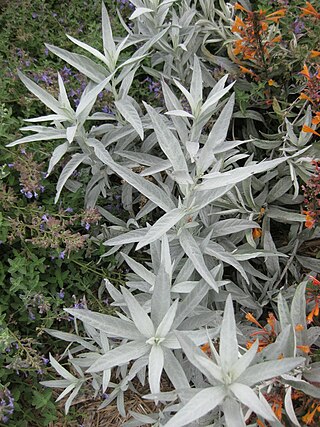
Artemisia ludoviciana is a North American species of flowering plant in the daisy family Asteraceae, known by several common names, including silver wormwood, western mugwort, Louisiana wormwood, white sagebrush, lobed cud-weed, prairie sage, and gray sagewort.
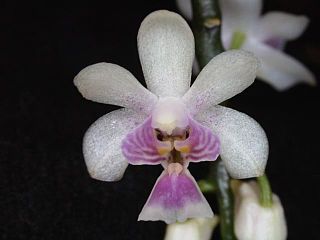
Phalaenopsis deliciosa is a species of orchid occurring from the Indian subcontinent to Malesia and China. The species is a miniature epiphytic herb. The leaves are unique due to their undulate margins. This characteristic greatly simplifies the identification of the species, even when specimens are not currently flowering. The small flowers are usually slightly pink, but white and yellow forms exist as well. Old inflorescences, which are usually panicles or more rarely racemes, may continue to grow and form new flowers over several flowering periods.

Cyclamen coum, the eastern sowbread, is a species of flowering plant in the family Primulaceae. It is a tuberous herbaceous perennial, growing to 5–8 cm (2–3 in), with rounded heart-shaped leaves and pink shell-shaped flowers with darker coloration at the base. It is valued in horticulture as groundcover, and for the flowers which bloom in winter and early spring.
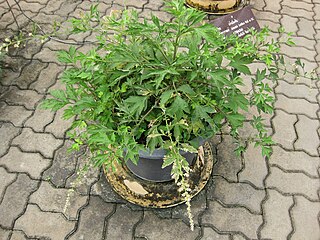
Artemisia lactiflora, the white mugwort, is a species of flowering plant in the daisy family, native to western China. It is a vigorous clump-forming herbaceous perennial growing to 1.5m, with plumes of creamy-white flower heads appearing in summer and autumn above dark green leaves. This is the only artemisia which is cultivated as much for its flowers as for its foliage. Plants grown in poor dry soil are hardier and last longer than those grown in heavy, damp soil.

Copiapoa hypogaea, the underground copiapoa, is a species of flowering plant in the genus Copiapoa in the cactus family (Cactaceae), native to northern Chile. It has gained the Royal Horticultural Society's Award of Garden Merit.

Rebutia neocumingii, the Cuming crown cactus, is a species of cactus in the genus Rebutia, endemic to Bolivia. It has gained the Royal Horticultural Society's Award of Garden Merit.




















